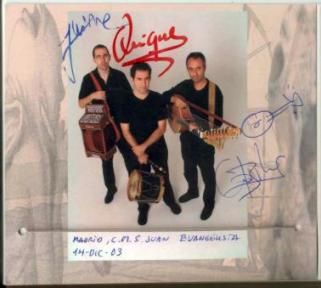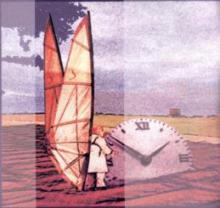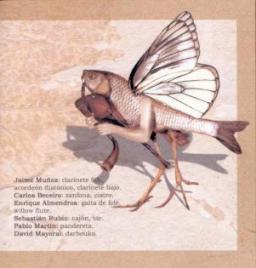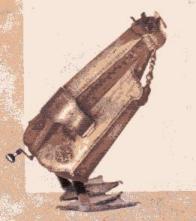FolkWorld article by Pio
Fernandez:
LA MUSGAÑA: THE RAT IS BACK
 Until
now, most FolkWorld articles on Spanish folk have talked about the traditional/folk
music from the northern (Atlantic) regions of the Iberian peninsula: Galicia,
Asturias, Cantabria and Basque Country, coming from bands with some 'Celtic'
music flavour. Let's introduce now a band from central Spain: Castilla, the
vast region that becomes the cultural bridge between the Atlantic and Mediterranean
coasts and their ancient traditions.
Until
now, most FolkWorld articles on Spanish folk have talked about the traditional/folk
music from the northern (Atlantic) regions of the Iberian peninsula: Galicia,
Asturias, Cantabria and Basque Country, coming from bands with some 'Celtic'
music flavour. Let's introduce now a band from central Spain: Castilla, the
vast region that becomes the cultural bridge between the Atlantic and Mediterranean
coasts and their ancient traditions.
Madrid, December 14th 2003, 7:30 p.m.. The auditorium of the 'Colegio Mayor
San Juan Evangelista' (college students residence well recognised for its jazz
concerts since 1970) is packed. Folk fans, journalists and musicians mainly
from the capital city of Spain (and middle point between the two Castillean
regions) are excited and expectant to see and listen again, after five years
of silence, to the folk band that in the late 80'S and 90's started a renovation
of the way to perform the traditional songs of the central Spain regions: Castilla-León
(north), Castilla-La Mancha (south), Extremadura (south-west),…
LA MUSGAÑA (meaning 'the water rat') is presenting tonight their latest
(sixth) CD named "Temas Profanos" ( Profane Themes ). Their previous one was
recorded in a brilliant concert back in 1997, produced by the late Scottish
fiddler Johnny Cunningham, where he also played
with La Musgaña together with top Spanish folk music guests such as:
Kepa Junquera, the band Radio Tarifa, Amancio Prada, Manuel Luna, Javier Paxariño,
Luis Delgado and others.
 Maybe
that notorious event for the folk community in 1997 did not bring the music
of La Musgaña to such high levels of commercial success as was happening
at that time to the Celtic sounds of northern bagpipers, such as Carlos Nuñez
or Hevia (quite often invited to popular shows in the Spanish TV channels).
Whatever the reason was, difficulties with the record company that published
that CD (and re-edited their initial ones), prevented us from enjoying more
music from La Musgaña, … until today.
Maybe
that notorious event for the folk community in 1997 did not bring the music
of La Musgaña to such high levels of commercial success as was happening
at that time to the Celtic sounds of northern bagpipers, such as Carlos Nuñez
or Hevia (quite often invited to popular shows in the Spanish TV channels).
Whatever the reason was, difficulties with the record company that published
that CD (and re-edited their initial ones), prevented us from enjoying more
music from La Musgaña, … until today.
La Musgaña is mainly integrated by two musicians from Madrid: Enrique
"Quique" Almendros (bagpipes, three holed flute and tabor,…) and Jaime Muñoz
(diatonic button accordion, clarinets, gaida, kaval,…), and one from El Ferrol
(Galicia), Carlos Beceiro (hurdy-gurdy and all kinds of string instruments).
They have now edited this new CD, with a record company founded by themselves
(Lubican Records), where other folk musicians participate with: their voices
(Joaquín Diaz, Carmen Paris, Maite Dono, Celia Bergara), and their instruments:
violin played by Diego Galaz, and traditional percussion instruments from all
over the world, played by Sebastian Rubio, David Mayoral and Pablo Martín.
 The
36 pages booklet in the CD includes the corresponding English translation of
all the Spanish texts which describe the subject and history of the songs. The
text, cover design and illustrations is very unique and was done by Enrique
Almendros himself. The title 'Temas Profanos / Profane Themes' makes reference
to topics of human life that in the past inspired the writing of popular songs
like the 16 ones included in the CD: "love, death, work, creation, hate, happiness,
sex, faith, …" . The tunes are mainly traditional dances from the Castilla-León
provinces, from the Madrid region, and from the province of Caceres (Extremadura
region, having borders with Castilla, Andalusia and Portugal).
The
36 pages booklet in the CD includes the corresponding English translation of
all the Spanish texts which describe the subject and history of the songs. The
text, cover design and illustrations is very unique and was done by Enrique
Almendros himself. The title 'Temas Profanos / Profane Themes' makes reference
to topics of human life that in the past inspired the writing of popular songs
like the 16 ones included in the CD: "love, death, work, creation, hate, happiness,
sex, faith, …" . The tunes are mainly traditional dances from the Castilla-León
provinces, from the Madrid region, and from the province of Caceres (Extremadura
region, having borders with Castilla, Andalusia and Portugal).
La Musgaña performs the traditional music of central Spain in a modern
style, and they also incorporate influences from all other kinds of traditional
musics, from the north-African beats (probably a main contributor to the Spanish
folklore even before the middle ages), to jazz music (Carlos Beceiro also played
double bass and bass guitar in jazz bands, as well as other styles of "new age/folk"
music with Xavier Paxariño).
Some time ago I talked to an ex-member of the initial formation of La Musgaña,
who compared their music with that from the English band Blowzabella. Maybe
what La Musgaña is doing with the Castillean folk music, could truly be compared
with Blowzabella's interpretation of the traditional and medieval sounds from
the British islands.
 But
what La Musgaña has really meant for the Castilean folk, is to lead a
new generation of bands that showed new possibilities from what the first generation
of Castilean bands started in the 70's and 80's (Nuevo Mester de Juglaría, Joaquín
Diaz, Habas Verdes, La Bazanca, Candeal,…). Among such new groups are for example:
Aljibe, Barahunda, La Bruja Gata or Balbarda. One of the differences between
both generations could be that the new one makes more use of many different
musical instruments in the interpretation of a wide variety of traditional dance
rhythms, although the singing does not take such a relevant role as on the older
generation. This is probably a common trend in most folk musics of Europe and
America, since during the 70's the social and political messages transmitted
in the lyrics were more dominant than the music itself, or the virtuosity on
playing ancient traditional or contemporary instruments.
But
what La Musgaña has really meant for the Castilean folk, is to lead a
new generation of bands that showed new possibilities from what the first generation
of Castilean bands started in the 70's and 80's (Nuevo Mester de Juglaría, Joaquín
Diaz, Habas Verdes, La Bazanca, Candeal,…). Among such new groups are for example:
Aljibe, Barahunda, La Bruja Gata or Balbarda. One of the differences between
both generations could be that the new one makes more use of many different
musical instruments in the interpretation of a wide variety of traditional dance
rhythms, although the singing does not take such a relevant role as on the older
generation. This is probably a common trend in most folk musics of Europe and
America, since during the 70's the social and political messages transmitted
in the lyrics were more dominant than the music itself, or the virtuosity on
playing ancient traditional or contemporary instruments.
No matter the way you want look at it, here in the center of the Iberian peninsula
we are just hopeful that maybe soon we will reach such a high level of public
interest in our regional trad & folk music, such as happened for instance in
Galicia, after the band Milladoiro and the fruitful following generation of
instrument players and bands (Carlos Núñez, Berrogüetto, X.M. Budiño, Mercedes
Peón, …).
To know more about the origins of La Musgaña you can read the article
from Steve Winick in the magazine Dirty Linen: "The Rat That Roared" ( www.dirtynelson.com/linen/feature/45lm.html
). You can also visit their web page at: www.lamusgana.com
.
Photo Credit: Press photo; drawings from the CD booklet.
Back to the content of FolkWorld
Features
To the content of FolkWorld No. 27
© The Mollis - Editors
of FolkWorld; Published 2/2004
All material published in FolkWorld is © The
Author via FolkWorld. Storage for private use is allowed and welcome. Reviews
and extracts of up to 200 words may be freely quoted and reproduced, if source
and author are acknowledged. For any other reproduction please ask the Editors
for permission. Although any external links from FolkWorld are chosen with greatest care, FolkWorld and its editors do not take any responsibility for the content of the linked external websites.
FolkWorld - Home of European Music

Layout & Idea of FolkWorld © The Mollis - Editors of FolkWorld
 Until
now, most FolkWorld articles on Spanish folk have talked about the traditional/folk
music from the northern (Atlantic) regions of the Iberian peninsula: Galicia,
Asturias, Cantabria and Basque Country, coming from bands with some 'Celtic'
music flavour. Let's introduce now a band from central Spain: Castilla, the
vast region that becomes the cultural bridge between the Atlantic and Mediterranean
coasts and their ancient traditions.
Until
now, most FolkWorld articles on Spanish folk have talked about the traditional/folk
music from the northern (Atlantic) regions of the Iberian peninsula: Galicia,
Asturias, Cantabria and Basque Country, coming from bands with some 'Celtic'
music flavour. Let's introduce now a band from central Spain: Castilla, the
vast region that becomes the cultural bridge between the Atlantic and Mediterranean
coasts and their ancient traditions.  Maybe
that notorious event for the folk community in 1997 did not bring the music
of La Musgaña to such high levels of commercial success as was happening
at that time to the Celtic sounds of northern bagpipers, such as Carlos Nuñez
or Hevia (quite often invited to popular shows in the Spanish TV channels).
Whatever the reason was, difficulties with the record company that published
that CD (and re-edited their initial ones), prevented us from enjoying more
music from La Musgaña, … until today.
Maybe
that notorious event for the folk community in 1997 did not bring the music
of La Musgaña to such high levels of commercial success as was happening
at that time to the Celtic sounds of northern bagpipers, such as Carlos Nuñez
or Hevia (quite often invited to popular shows in the Spanish TV channels).
Whatever the reason was, difficulties with the record company that published
that CD (and re-edited their initial ones), prevented us from enjoying more
music from La Musgaña, … until today.
 The
36 pages booklet in the CD includes the corresponding English translation of
all the Spanish texts which describe the subject and history of the songs. The
text, cover design and illustrations is very unique and was done by Enrique
Almendros himself. The title 'Temas Profanos / Profane Themes' makes reference
to topics of human life that in the past inspired the writing of popular songs
like the 16 ones included in the CD: "love, death, work, creation, hate, happiness,
sex, faith, …" . The tunes are mainly traditional dances from the Castilla-León
provinces, from the Madrid region, and from the province of Caceres (Extremadura
region, having borders with Castilla, Andalusia and Portugal).
The
36 pages booklet in the CD includes the corresponding English translation of
all the Spanish texts which describe the subject and history of the songs. The
text, cover design and illustrations is very unique and was done by Enrique
Almendros himself. The title 'Temas Profanos / Profane Themes' makes reference
to topics of human life that in the past inspired the writing of popular songs
like the 16 ones included in the CD: "love, death, work, creation, hate, happiness,
sex, faith, …" . The tunes are mainly traditional dances from the Castilla-León
provinces, from the Madrid region, and from the province of Caceres (Extremadura
region, having borders with Castilla, Andalusia and Portugal).
 But
what La Musgaña has really meant for the Castilean folk, is to lead a
new generation of bands that showed new possibilities from what the first generation
of Castilean bands started in the 70's and 80's (Nuevo Mester de Juglaría, Joaquín
Diaz, Habas Verdes, La Bazanca, Candeal,…). Among such new groups are for example:
Aljibe, Barahunda, La Bruja Gata or Balbarda. One of the differences between
both generations could be that the new one makes more use of many different
musical instruments in the interpretation of a wide variety of traditional dance
rhythms, although the singing does not take such a relevant role as on the older
generation. This is probably a common trend in most folk musics of Europe and
America, since during the 70's the social and political messages transmitted
in the lyrics were more dominant than the music itself, or the virtuosity on
playing ancient traditional or contemporary instruments.
But
what La Musgaña has really meant for the Castilean folk, is to lead a
new generation of bands that showed new possibilities from what the first generation
of Castilean bands started in the 70's and 80's (Nuevo Mester de Juglaría, Joaquín
Diaz, Habas Verdes, La Bazanca, Candeal,…). Among such new groups are for example:
Aljibe, Barahunda, La Bruja Gata or Balbarda. One of the differences between
both generations could be that the new one makes more use of many different
musical instruments in the interpretation of a wide variety of traditional dance
rhythms, although the singing does not take such a relevant role as on the older
generation. This is probably a common trend in most folk musics of Europe and
America, since during the 70's the social and political messages transmitted
in the lyrics were more dominant than the music itself, or the virtuosity on
playing ancient traditional or contemporary instruments.
